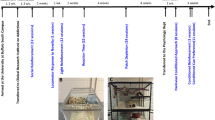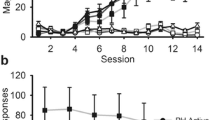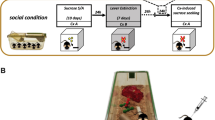Abstract
Rationale
Previous research has determined that rats reared in an enriched condition (EC) are more sensitive to the effects of acute systemic amphetamine than rats raised in an impoverished condition (IC).
Objectives
The present experiments examined the effect of environmental enrichment on locomotor activity following repeated injections of nicotine. Experiment 1 assessed differences in locomotor activity in EC and IC rats and experiment 2 assessed differences between EC rats and rats housed in pairs without novel objects or daily handling (social condition; SC) to determine whether enrichment causes changes beyond that of social contact alone.
Methods
In experiment 1, EC and IC rats were treated with saline, 0.2 mg/kg or 0.8 mg/kg nicotine, and locomotor activity was assessed for 60 min. Nicotine-induced activity was measured every 48 h for a total of eight sessions. All rats were challenged with 0.8 mg/kg nicotine on session 9. In experiment 2, EC and SC rats were treated with saline or 0.2 mg/kg nicotine, and locomotor activity was assessed using the same regimen as in experiment 1.
Results
In experiment 1, EC rats exhibited less sensitivity than IC rats to the psychostimulant effect of nicotine upon both acute and repeated administration. On the nicotine challenge session (session 9), EC rats were again less sensitive to the hyperactive effects of nicotine. In experiment 2, EC rats were also less sensitive than SC rats to nicotine-induced hyperactivity across repeated injections.
Conclusions
These results suggest that environmental enrichment during development reduces the stimulant effect of nicotine.





Similar content being viewed by others
References
Adams J, Bowman K, Burke B, Casson L, Caviness L, Coffey LE, Devore J, Durham J, Ellis C, Hewitt D, Hinsdale M, Johnson I, Myers S, Penne M, Zelon H (1999) 1999 National household survey on drug abuse data collection final report. National Institute on Drug Abuse, Bethesda
Bardo MT, Hammer RP (1991) Autoradiographic localization of dopamine D1 and D2 receptors in rat nucleus accumbens: resistance to differential rearing conditions. Neuroscience 45:281–290
Bardo MT, Bowling SL, Rowlett JK, Manderscheid P, Buxton ST, Dwoskin LP (1995) Environmental enrichment attenuates locomotor sensitization, but not in vitro dopamine release, induced by amphetamine. Pharmacol Biochem Behav 51:397–405
Bardo MT, Valone JM, Robinet PM, Shaw WB, Dwoskin LP (1999) Environmental enrichment enhances the stimulant effect of intravenous amphetamine: search for a cellular mechanism in the nucleus accumbens. Psychobiology 27:292–299
Bardo MT, Klebaur JE, Valone JM, Deaton C (2001) Environmental enrichment decreases intravenous self-administration of amphetamine in female and male rats. Psychopharmacology 155:278–284
Bowling SL, Bardo MT (1994) Locomotor and rewarding effects of amphetamine in enriched, social, and isolate reared rats. Pharmacol Biochem Behav 48:459–464
Bowling SL, Rowlett JK, Bardo MT (1993) The effect of environmental enrichment on amphetamine-stimulated locomotor activity, dopamine synthesis and dopamine release. Neuropharmacology 32:885–893
Cador M, Dulluc J, Mormede P (1993) Modulation of the locomotor response to amphetamine by corticosterone. Neuroscience 56:981–988
Carroll ME (1996) Reducing drug abuse by enriching the environment with alternative nondrug reinforcers. In: Advances in Behavioral Economics. Ablex Pub, Norwood, pp 37–68
Clarke PBS, Kumar R (1983) The effects of nicotine on locomotor activity in non-tolerant and tolerant rats. Br J Pharmacol 78:329–337
Comings DE (1996) Genetic factors in drug abuse and dependence. NIDA Res Monogr 159:16–38
Dwoskin LP, Crooks PA, Teng L, Green TA, Bardo MT (1999) Acute and chronic effects of nornicotine on locomotor activity in rats: altered response to nicotine. Psychopharmacology 145:442–451
Faraday MM, Scheufele PM, Rahman MA, Grunberg NE (1999) Effects of chronic nicotine administration on locomotion depend on rat sex and housing condition. Nicotine Tob Res 1:143–151
Gentsch C, Lichtsteiner M, Frischknecht HR, Feer H, Siegfried B (1988) Isolation-induced locomotor hyperactivity and hypoalgesia in rats are prevented by handling and reversed by resocialization. Physiol Behav 43:13–16
Green TA, Gehrke BJ, Bardo MT (2002) Environmental enrichment decreases intravenous amphetamine self-administration: dose response functions for fixed- and progressive-ratio schedules. Psychopharmacology 162:373–378
Hart C, Ksir C (1996) Nicotine effects on dopamine clearance in rat nucleus accumbens. J Neurochem 66:216–221
Liang NY, Rutledge CO (1982) Comparison of the release of [3H]dopamine from isolated corpus striatum by amphetamine, fenfluramine and unlabelled dopamine. Biochem Pharmacol 31:983–992
Marashi V, Barnekow A, Ossendorf E, Sachser N (2003) Effects of different forms of environmental enrichment on behavioral, endocrinological, and immunological parameters in male mice. Horm Behav 43:281–292
McGue M, Lykken DT, Iacono WG (1996) Genotype-environment correlations and interactions in the etiology of substance abuse and related behaviors. NIDA Res Monogr 159:49–72
Phillips GD Howes SR, Whitelaw RB, Wilkinson LS, Robbins TW, Everitt BJ (1994) Isolation rearing enhances the locomotor response to cocaine and a novel environment, but impairs the intravenous self-administration of cocaine. Psychopharmacology 115:407–418
Schoffelmeer AN, De Vries TJ, Wardeh G, van de Ven HW, Vanderschuren LJ (2002) Psychostimulant-induced behavioral sensitization depends on nicotinic receptor activation. J Neurosci 22:3269–3276
Smith JK, Neill JC, Costall B (1997) Post-weaning housing conditions influence the behavioural effects of cocaine and D-amphetamine. Psychopharmacology 131:23–33
Stolerman IP, Garcha HS, Mirza NR (1995) Dissociations between the locomotor stimulant and depressant effects of nicotinic agonists in rats. Psychopharmacology 117:430–437
Vizi ES, Lendvai B (1999) Modulatory role of presynaptic nicotinic receptors in synaptic and non-synaptic chemical communication in the central nervous system. Brain Res Rev 30:219–235
Zimmermann A, Stauffacher M, Langhans W, Wurbel H (2001) Enrichment-dependent differences in novelty exploration in rats can be explained by habituation. Behav Brain Res 121:11–20
Acknowledgements
Research was funded by USPHS grants DA05312 and DA12964. TAG supported by the Interdepartmental Neuroscience Program and the Research Challenge Trust Fund at the University of Kentucky, and USPHS grant F31 DA06093. MEC supported by USPHS grant F32 DA16013.
Author information
Authors and Affiliations
Corresponding author
Rights and permissions
About this article
Cite this article
Green, T.A., Cain, M.E., Thompson, M. et al. Environmental enrichment decreases nicotine-induced hyperactivity in rats. Psychopharmacology 170, 235–241 (2003). https://doi.org/10.1007/s00213-003-1538-3
Received:
Accepted:
Published:
Issue Date:
DOI: https://doi.org/10.1007/s00213-003-1538-3




